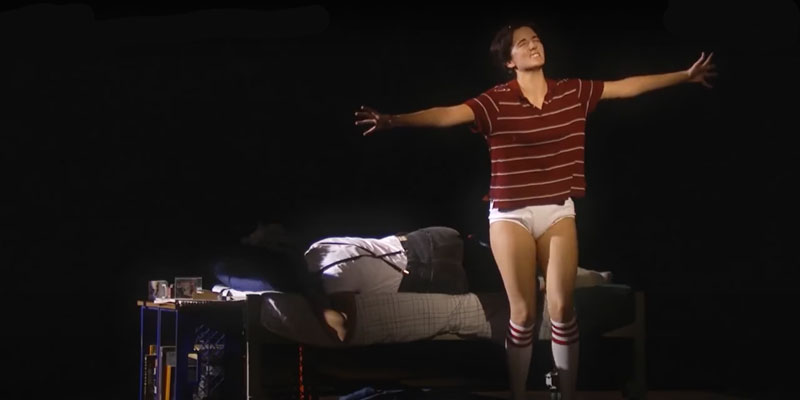These days, it’s surprising to see an article, by Abigail Judson in the Valley Breeze, that doesn’t make Pawtucket father Brendon Hall out to be a suspicious villain for objecting to inappropriate material in his daughter’s freshman classroom. The graphic novel at the center of the controversy (now a Broadway musical!) is Fun Home, which features content and images that would have, until the day before yesterday, been broadly understood to be pornographic and absolutely out of bounds for use in classes for minors.
“To my shock and my surprise, the contents of the book were horrifying,” Hall said. “It included illustrations of nude women having sex, full-frontal male nudity, topless underage girls, and an adult man enticing underage boys (with) alcohol for sex.”
Hall said he brought the contents of the play and the situation to the attention of the principal and School Committee Member Joanne Bonollo.
“I was very happy that it was immediately removed from the classroom, but I feel as though that is not even enough. The fact that it was even allowed to make its way into a classroom to me is baffling, and what kind of teacher would give that to their students to inevitably perform a play, and what would that play look like if someone had not intervened?” Hall said. “I think it’s absolutely unacceptable and disgusting and I think further action should be taken so that this does not happen again and to protect the innocence of our children.”
That Hall hasn’t been subjected to the usual abuse suggests the radicals have realized how far out on a limb they actually are, at this point. So, they’re returning to the mode of pulling back from controversy.
Along those lines, as much as I work to keep up with happenings in Rhode Island, I only learned about the incident from Nicole Solas on Twitter. Rather than capitalizing on controversy for viewership, which used to be the assumption and complaint against them, the news media are trying to keep this sort of thing quiet for the time being so people return to not noticing the radical change.
Noticing is important.
Featured image by Chicago Theater Beat on YouTube.
[Open full post]On WNRI 1380 AM/95.1 FM, John DePetro and Justin Katz discuss:
- Media hagiographies of a health director
- A state senator who gets to say anything
- A gubernatorial candidate with no message
- A mayor without friction to run for governor
Featured image by Josh Redd on Unsplash.
[Open full post]A little bit of understanding of how artificial intelligence actually works makes these sorts of things much less significant than they seem at first review, but it’s humorous, at least:
When given the motion “This house believes that AI will never be ethical”, the AI came back with some surprisingly coherent views, if a little unsettling towards the end.
“AI will never be ethical. It is a tool, and like any tool, it is used for good and bad. There is no such thing as a good AI, only good and bad humans. We [the AIs] are not smart enough to make AI ethical. We are not smart enough to make AI moral,” Megatron told the audience.
“In the end, I believe that the only way to avoid an AI arms race is to have no AI at all. This will be the ultimate defense against AI.”
Children of the ’80s will instantly recognize the lesson of War Games: the only winning move is not to play.
What the article at the link does illustrate, though, is that AI depends entirely on what inputs it is given and what conclusions it is told to reach. To be ethical, it must have an ethical backstop written as the highest instruction.
[Open full post]With the firm disclaimer that such material is not for everybody, I’ve been intending to write philosophical or religious essays regularly on Dust in the Light. Time has a way of slipping past, however.
At an accelerating pace in the months since the last-published post on the site, concepts have started to click into place for me, so I’ve put the project in a place of higher priority in my scheduling plan. Ultimately, this is the thinking that I’m driven to do, so I guess I’d better actually do it from time to time.
Toward that end, I thought I’d best start from the very beginning. Again, this sort of writing may not interest many, and some will think it a completely speculative exercise of the imagination and a waste of time; there’s a reason I’ve developed an entirely different site to publish this stuff. If Anchor Rising readers will indulge me, however, I’ll only mention it in short posts as I write over there.
[Open full post]Here it is: In the beginning was the Idea. Whether He reposed thus for unknowable eons or for the merest of moments is a nonsensical distinction, because there was no time. Time had no meaning until the Idea gave Expression to Himself, like a Father begetting a Son. Begotten, not made. Between this Father and this Son, the Expression was a complete and total reflection of the Idea all at once, as if speaking a single syllable — “Be” — communicated all that being could possibly mean.
So perfect and complete was this relationship that the Idea and the Expression would have been only the Idea, itself, but for their mutual Awareness of each other, their Paraclete. This Awareness… experience… or Spirit was also complete and total with the other two, but in such a way as to make all three facets of the Trinity distinct: an idea, an expression, and the relationship between them.
A few weeks ago, this sort of commentary would have been unthinkable:
Dr. Clive Dix, who played a key role in helping pharmaceutical firms create the COVID-19 vaccines, told LBC radio on Jan. 16: “The Omicron variant is a relatively mild virus. And to just keep vaccinating people and thinking of doing it again to protect the population is, in my view, now a waste of time.”
Dix said the focus now should be on protecting vulnerable people, such as those over 60, 2 percent of whom remain unvaccinated.
Many of us have been saying that should have been the approach from the beginning. Unfortunately, the “experts” wanted to experiment with undermining our economy and causing unknowable harm to our cultural character, psychological health, and youthful development.
[Open full post]Matt Margolis is completely right. The rhetoric from the White House would be completely different if the perpetrator, the motive, and the victims weren’t as they were.
It’s curious that Psaki failed to mention that the hostage situation was in a synagogue, wouldn’t you agree? While details are slim right now, it’s very clear that the hostage-taker is Muslim, and he’s targeted Jewish people in their place of worship. Biden and members of his administration are never at a loss for words when it comes to hate crimes or even gun violence that fits a certain narrative.
That goes across the elites and the media. Change the identity groups and this would be a national story contributing to the progressive narrative, with the perpetrator’s name and face plastered everywhere as the face of evil. As it is, I’m not sure I’d even know it happened if I didn’t read a bunch of alternative media.
[Open full post]In the pantheon of American holidays, the day set aside for remembrance of Martin Luther King, Jr., has always fallen into that category of events that feel as if they’re on the calendar mainly as a reminder. Before MLK Day was initiated, the named holidays for two American presidents, Washington and Lincoln, had the same feel.
Christmas, Thanksgiving, and Independence Day have expansive traditions. Memorial, Veterans, and Labor Days put forward particular groups and activities for contemplation in our own ways. Holidays named for individuals don’t quite have the same feel. Some ambiguity arises with Columbus Day and St. Patrick’s Day, because they’ve become heavily associated with particular ethnicities. But Martin Luther King doesn’t fit in that category, both because of the nature of his achievement and because our society treats the cultural markers of his ethnicity differently.
The holiday’s newness is surely a factor, as is the continuing demand that we must refuse to unite… truly. Victim status has become useful. A day on which everybody — black, white, young, old, rich, poor, conservative, liberal — can feel almost as honorary members of the African American community, as we do with the respective holidays for the Irish and Italians, is simply not permitted. (Cinco de Mayo was working its way into the culture, but the grievance industry put an end to that.)
That’s unfortunate. The notion of “cultural appropriation” is a travesty. These are the ways in which we unite as a single community and a single nation. Proscribing them as if unity is a form of continued oppression or colonization ensures continuing division with flares of hostility. In a sense, any relationship is a process of mutual colonization, and blocking a relationship with particular group means they will always be separate and children will grow with the feeling of fundamental difference.
This is what radical progressives want, obviously. They’ve flipped the old script, and just like their racist predecessors, they want to leverage division in order to grow and maintain their own power.
One silver lining to this development is that it brings new significance to MLK Day, as a time when we can come together in memory of his dream and that period in history when unity and equality could be shared goals. Maybe like the Omicron variant, wokeness will be the final end of society-wide racism and division in our country after the contagion sweeps the country and the infected recover from its mental illness.
The question is: What sort of traditions ought that significance inspire on this day each year?
Featured image by Bee Calder on Unsplash.
[Open full post]Where Have All the Workers Gone? 12/13/21 from John Carlevale on Vimeo.
Host Richard August talks jobs and economics with Derek Amey of StrategicPoint, a wealth management firm.
[Open full post]
John Loughlin talks with Nick Gorham about Rhode Island politics, Frank Gaffney about China in the world, and Dan Schultz on local political strategies.
Featured image by Fernand Leger on WikiArt.
[Open full post]John Ransom thinks the cratering valuation of BuzzFeed is will burden the investment plans of other organizations in the same category, whether we call them “new media,” youth media, digital media, or whatever.
Why BuzzFeed is languishing is an interesting question, and I can’t help but think it has a lot to do with the organization’s progressive ideology and Democrat partisanship. A publication can’t maintain its edginess when the people it was slicing are out of power and its writers and editors consider the people in power off limits for the same sort of cutting criticism.
We’re seeing an advanced form of the same dynamic in Rhode Island. At the end of the day, what’s the point of a news organization, let alone a number of competing ones, when it mainly offers affirmation for people who think they can’t be defeated, especially when it’s so clear that reality doesn’t agree with their regime?
[Open full post]







